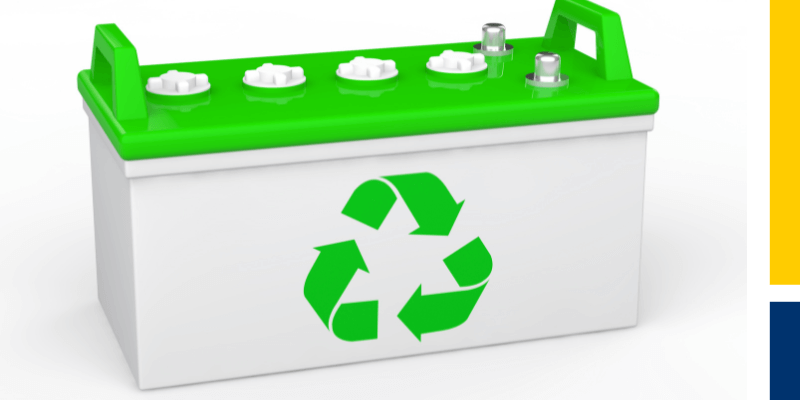Battery sustainability is front and center in the news – and it’s important for the environment and your bottom line.
But whether you’re using recyclable lead-acid or absorbent glass mat (AGM) batteries or lithium-based models….
PROBLEM: There's a lot of hype and greenwashing in the battery industry.
And it's difficult to tell what actually matters when evaluating battery sustainability and longevity.
SOLUTION: In today's blog post, you'll learn all the basics of battery sustainability, including:
- How do we get to Zero Battery Waste – and how does it impact you?
- Which batteries are 95% landfilled – and which ones are 99% recycled?
- Top battery killers – and how to improve lifespan
- Simple strategies that minimize your batteries’ carbon footprint and improve reliability
- And more
How does battery waste impact you – and how do we get to Zero Waste?
When battery manufacturers waste resources, you foot the bill…
… and all of us pay the environmental cost.
But when you look at a battery’s price tag, what you can’t see, can hurt you – and you’ll pay the price later:
- Outdated manufacturing techniques like stamped plates (energy-storing grids)
- Poor engineering
- Inadequate manual testing
- Non-recyclable materials
By contrast, aiming for zero-waste battery production conserves resources and reduces manufacturing costs – not by cutting corners, but by maintaining quality and reducing waste.
For instance, Crown Battery’s extensive on-site recycling, energy-efficiency programs, and reinvented R&D and production processes decrease manufacturing costs.
And the cornerstone of sustainable battery manufacturing is battery recycling.
Are your batteries recycled?
According to the U.S. EPA, lead-acid and AGM batteries boast a 99% recycling rate, surpassing even aluminum cans. This high recycling rate lessens the need for new raw materials, thereby mitigating environmental damage.
By contrast, a mere 5% of Lithium-ion batteries are recycled (source: Chemical & Engineering News’s “It's time to get serious about recycling lithium-ion batteries).
For further details, including efforts to bridge the gap in Battery Recycling, watch "The Recycling Gap: Will Your Battery Recycle or Will You Pay the Disposal Bill?"

Choose batteries with lower carbon emissions
Lead-acid and AGM batteries, especially those produced using renewable energy, have considerably lower carbon footprints than other battery types.
Take a September 2023 study by Sphera Solutions (ISO 14040/44 standard), for example. The study commissioned by Battery Council International and the International Lead Association assessed the entire lifecycle of lead-acid, AGM, and Lithium-iron phosphate batteries used in vehicles.
The findings revealed that lead-based batteries have a lower global warming potential and manufacturing burdens 39%-90% lower than their Lithium-Iron Phosphate counterparts.
Read “Comparative LCA of Lead and LFP Batteries for Automotive Applications” report for more information.
Simple steps extend lifespan and combat early battery failure
The longer batteries last, the more sustainable they are – and the less you’ll have to replace them.
With a few simple steps, you can prolong any battery's lifespan. Here are the basics:
- Learn which battery features make batteries last longer in the first place. (More on this in a minute.)
- Avoid overcharging by using a smart charger or monitoring batteries more closely.
- Size your battery system so you don't deep-discharge beyond the manufacturer's guidelines. If you need help, your battery distributor or manufacturer can walk you through everything.
- Store, charge, and operate batteries in dry conditions with moderate temperatures.
- Create a schedule to perform regular inspections and maintenance as your manufacturer recommends. (Note that every battery, including "maintenance-free" absorbent glass mat (AGM) and lithium-ion, requires at least periodic checks for corrosion and wire damage.)
- To optimize battery maintenance, invest in quality maintenance tools and store them near batteries for easy access, use manufacturer checklists, and put maintenance in your calendar.
Understanding and implementing best practices for storage, charging, and maintenance help prevent battery issues – and extend battery life.
Compare battery R&D and manufacturing processes
When companies use smarter R&D and build batteries with recycled materials and robotics, the batteries are generally more sustainable – and last longer with fewer hassles.
Here’s how Crown Battery stacks up:
- 3D modeling and 3D printing improve R&D accuracy and speed.
- Batteries use approximately 80% recycled materials, lowering their raw material and carbon footprints.
- Renewable energy in Manufacturing improves sustainability, an industry first that led Crown to become the US EPA’s first Green Power Partner.

- Robotic assembly, including intercell welding and cell pressurization, improves reliability while lowering waste and warranty claims.
- 250+ point quality assurance helps batteries last longer.
- We are transparent about our sustainability programs, recyclability and reclamation statistics, energy efficiency efforts, and waste reduction.
“[Crown batteries] use vibration-resistant plate wrapping and robotic assembly. And if you feel the difference in weight between Crown batteries and models from other companies, it’s significant; there’s more raw material for chemical reactions.”
– Glen Matthews, Owner of Port Whitby Marine Supplies
Be sure your battery manufacturer follows these best practices – for high performance that’s better for your wallet and the environment.
Next Steps:
To reduce your carbon footprint and get more from your batteries, click here to download your free copy of Crown Battery’s Zero Battery Waste Guide. You’ll get comprehensive strategies for selecting sustainable batteries and enhancing their lifespan and ROI.












